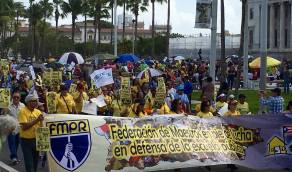Something else began happening after 2000: labor in general began losing ground relative to capital. After decades of stability, the share of national income going to employee compensation began dropping fairly fast.A big DUHHHHH! Just check out what has been happening to teachers and their unions -- often with the collaboration of our own leadership -- but I would take that back to 1975 - which I'll talk about at the end of this blog post.
... Paul Krugman, reviewing Robert Reich book in NY Review of Books.
I generally love Paul Krugman's analysis but he always stops short - at times very short - not only in his analysis but in ignoring so many obvious historical facts. (Thanks to Harris Lirtzman for linking to this on FB.)
There is a lot of food for thought in Krugman's review of Robert Reich's new book, Saving Capitalism: For the Many, Not the Few
I was bothered by a bunch of stuff.
As Krugman takes us through the way economists looked at the growing income gap (which has a hell of a lot to do with the achievement gap but people like Krugman and Reich who either support or ignore the Obama assault on education stay mum) I keep thinking that Marx pretty well predicted the concentration of economic power which then concentrates political power in the hands of an increasingly few people - the 1% of the 1%.
Then comes this Krugman comment on the Reich solutions:
In his proposals for new policies, Reich calls for a sort of broad portfolio, or maybe a market basket, of changes aimed mainly at “predistribution”—changing the allocation of market income—rather than redistribution. (In Reich’s view, this is seen as altering the predistribution that takes place under current rules.) These changes would include fairly standard liberal ideas like raising the minimum wage, reversing the anti-union bias of labor law and its enforcement, and changing contract law to empower workers to take action against employers and debtors to assert their interests against creditors. Reich would also, in a less orthodox move, seek legislative and other changes that might move corporations back toward what they were a half-century ago: organizations that saw themselves as answering not just to stockholders but to a broader set of “stakeholders,” including workers and customers.These guys really have to be in a dream state given the realities of today.
Enforce contract law in a court system stacked on one side?
Give me a break. How can Krugman ignore the power of labor to strike is what helped build unions? And he and Reich don't dare go and examine the powerful role the left played in building militant unionism in the 1930s before being purged which left the leadership of unions in the hands of an entirely different breed. I read so m any comments about how the UFT has changed since Shanker - but in reality, Shanker's militarism was often narrow-based and because I was active in the critical opposition from 1970 on I saw up close the wearing away of conditions from the ground up while the leadership continued to flourish until Bloomberg took over the system and reduced their role in helping run the system that always has screwed the teachers.
They seem to act like unions have had no role to play in their own destruction. Or rather union leadership. Just check out a few of my fellow bloggers recently pointing out so many illustrations relating to UFT policy at the end of this article.
Krugman mentions the New Deal as if the policies had nothing to do with the enormous pressure - and threats - from below due to the depression and the organizing going on in response. As if Roosevelt did what he did in a vacuum.
And of course when Krugman or Reich talk about the loss of union power do they touch on the passive and collaborationist response of an often corrupt union leadership which has lost the trust of so many of its members. Read the blogs and see how many UFT members can't wait for the Unity leadership to face the consequences of Friedrichs. Why is this nation so anti-union? Let's never ignore that oligarchical and repressive union leadership like Unity Caucus has a power to make their own people suspicious of the leadership which often translates into anti-unionism itself. Is it an accident that only 20% of the membership votes in elections? Or are they voting with their feet - the Don't Give a Crap vote.
I left this comment on FB on Harry's posting this piece:
I am trying to apply some of the theories to what happened to the UFT and teacher unions in general. While there was an illusion of power in effect the UFT began to lose power as a result of the 68 strike which was lauded as an extreme example of teacher power. But it wasn't. Immediately or soon after, class size reduction dropped off the table and teacher salaries began to slow down in growth. Liberals were in the process moving away from unions as witness the Woody Allen Shanker line in Sleeper. The 1975 strike which was sold out by a leadership which meekly accepted the layoffs of 15,000 people and drastic cuts in working conditions was pretty much the beginning of the end. As Krugman points out things began to really move in the 80s as the anti-union movement gathered force and how did the UFT/AFT respond? By jumping on board, if not helping to lead, the ed deform movement. Shanker partnered with the Clintons in Arkansas and Regan too. The Kahlenberg Shanker bio has the entire story but from a Shanker favorable POV. No wonder Eli Broad helped support that bio - linking the unions to ed deform.Here are some excerpts from the Krugman review in NY Review of Books.
Something else began happening after 2000: labor in general began losing ground relative to capital. After decades of stability, the share of national income going to employee compensation began dropping fairly fast. One could try to explain this, too, with technology—maybe robots were displacing all workers, not just the less educated. But this story ran into multiple problems. For one thing, if we were experiencing a robot-driven technological revolution, why did productivity growth seem to be slowing, not accelerating? For another, if it was getting easier to replace workers with machines, we should have seen a rise in business investment as corporations raced to take advantage of the new opportunities; we didn’t, and in fact corporations have increasingly been parking their profits in banks or using them to buy back stocks.Other bloggers on UFT/NYSUT alienation of union members in the face of Friedrichs:
---
Meanwhile, forms of market power that benefit large numbers of workers as opposed to small numbers of plutocrats have declined, again thanks in large part to political decisions. We tend to think of the drastic decline in unions as an inevitable consequence of technological change and globalization, but one need look no further than Canada to see that this isn’t true. Once upon a time, around a third of workers in both the US and Canada were union members; today, US unionization is down to 11 percent, while it’s still 27 percent north of the border. The difference was politics: US policy turned hostile toward unions in the 1980s, while Canadian policy didn’t follow suit. And the decline in unions seems to have major impacts beyond the direct effect on members’ wages: researchers at the International Monetary Fund have found a close association between falling unionization and a rising share of income going to the top one percent, suggesting that a strong union movement helps limit the forces causing high concentration of income at the top.6
Following his schema, Reich argues that unions aren’t so much a source of market power as an example of “countervailing power” (a term he borrows from John Kenneth Galbraith) that limits the depredations of monopolists and others. If unions are not subject to restrictions, they may do so by collective bargaining not only for wages but for working conditions. In any case, the causes and consequences of union decline, like the causes and consequences of rising monopoly power, are a very good illustration of the role of politics in increasing inequality.
---
But why has politics gone in this direction? Like a number of other commentators, Reich argues that there’s a feedback loop between political and market power. Rising wealth at the top buys growing political influence, via campaign contributions, lobbying, and the rewards of the revolving door. Political influence in turn is used to rewrite the rules of the game—antitrust laws, deregulation, changes in contract law, union-busting—in a way that reinforces income concentration. The result is a sort of spiral, a vicious circle of oligarchy. That, Reich suggests, is the story of America over the past generation. And I’m afraid that he’s right. So what can turn it around?
- COPE SALES PITCH FALLS FLAT
- LATEST DA GIVES EVEN MORE PROOF UFT IS PART OF DE ...
- ICE-UFT BLOG 100% WITH BETH DIMINO
- LIVE BLOGGING FROM NOVEMBER DA (Sorry for any erro...
- SCORE ONE FOR RANDI'S HILLARY ENDORSEMENT BUT I AM...
- CAN OPT-OUT REALLY DOUBLE WITHOUT NYC SUPPORT?
- ARE NYC TEACHER WORKING CONDITIONS RETURNING TO 19...
- The Specter of Friedrichs Haunts Mike Mulgrew
- DA Takeaway November 2015
- My "Real Discussion" on Test-Based Teacher Evaluat...
- NY State's Unity Caucus Launches a Despicable Atta...
- I Ain't Gonna Work on Mulgrew's Farm No More














